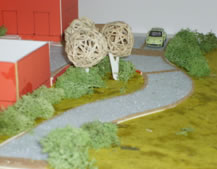The Mulch - Spring offering 2008
Thinking Inside the Box
What is it about sheds? I took possession of a new shed for an empty spot in my back garden last summer and it’s quickly become my favourite spot to perch, potter and ponder ever since, despite being the smallest (and most cluttered) room I have!
And, it appears that I am not alone. According to Saga Insurance, more than half of Britons have a shed somewhere on their property and more than a quarter of homeowners have installed a shed since they moved to their current homes.
It seems that there’s something deeply primal about our relationship to the humble shed. Dr Earle, professor of Gerontology in Australia, says: “The shed is a therapeutic centre because it gives men a sense of purpose. It’s a centre of identity because it links men with their past, present and future.”
But sheds are not solely the preserve of men. The Telegraph found in a recent survey that 40% of women compared to 38% of men considered the shed to be an important private space in their gardens.
. And did you know that the word ‘shed’ comes from the Anglo-Saxon word for shade or partial darkness: ‘scead’. Curiously, it’s also related to the words for separation and ‘apartness’ and this could help explain why sheds became associated with hermit-like activity, away from the crowds. Are we shed-owners simply following a strong and ancient urge?

< Cabin Fever: custom-designed to fit snugly into an awkward space, this little wooden outbuilding has quickly turned into my favourite room
Seed Identification Chart |
Black, papery
 |
Red, gritty, hard
 |
Carrot-shaped, hairy
 |
Agapanthus africanus ‘Alba’ |
Tricyrtis Formosa (Toad Lily) |
Ligularia dentata |
Tiny dots
 |
Black, gritty, hard
 |
Beige, smooth
 |
Papaver orientale (Poppy) |
Galtonia candicans (Summer Hyacinth) |
Sorry, lost the
details for these! |
Walking a Quiet Path
More than 20 people came along to an open workshop on Saturday 8th March to find out more about the ‘Walking a Quiet Path’ project in parks and gardens across Southampton this summer.
The workshop gave participants an opportunity to learn about labyrinths and how they can be used in parks and gardens. We discovered the differences between mazes and labyrinths, explored the history and symbolism of the labyrinth, practised making labyrinths on paper and then marked out three large labyrinths in sand on the grassy areas of the Common.
The ‘Walking A Quiet Path’ project is the result of several months of talks, meetings and site visits with representatives from parks groups across the city and Adrian Crook and Hilary Bradley at Southampton City Council. Hilary has secured funding for the project from the BBC Breathing Places grants scheme.
The workshop brought together interested local people to explore the practical issues around creating turf-based labyrinths across the city during April / May and to develop a network of local labyrinth enthusiasts. The labyrinths will be in place until the autumn and are for the benefit of anyone who wants to walk a quiet path in their local park.

> Running Rings: A group of labyrinth makers at a recent workshop complete a seven-circuit labyrinth on the Common in Southampton using sand, bamboo canes and twine
All Sewn Up…
Collecting seeds is one of the most cost-effective and satisfying things we gardeners can do. Last autumn I dried and stored a number of different seed types and decided to give them away through my mailing lists over the winter.
If you were wondering what type of ‘mystery’ seeds you had received (I hadn’t labelled the packets!), here’s a quick identification chart. There are some packets left, so please let me know if you’d like to receive some in time for spring sowing.
Come Rain or Shine…
How many of us have been wondering about the sort of summer we are going to have this year? Last summer would have tested the resilience of many of our borders and new planting schemes but I, for one, was grateful for the cool and wet weather.
Following on from the hot summer of 2006 came the unusually dry and mild winter and the hot and dry spell in the spring. Despite all this, there were a number of plants that caught my eye because of the reliable way they coped with all these extremes. Here’s my top performers of last year:
 |
SPRING: Snake’s Head Fritillary
(Fritillaria meleagris)
Exquisite flower heads glow in sunlight. Great for undisturbed spots in dappled shade. See them naturalised in grass in Bournemouth winter gardens this spring. |
 |
SUMMER: Penstemon sp.
Ever reliable, long-flowering semi-evergreen perennials. Vivid colours and great ‘linkers’ between flowering periods in any border. |
 |
AUTUMN: Toad Lily
(Tricyrtis Formosana)
No worries about this plant’s hardiness: I saw it flourishing in Quebec a couple of years ago. An under-rated performer that brightens a shady spot with divinely flecked, pinky white flowers. |
 |
(early) WINTER: Tree Mallow
(Lavatera x Clementii ‘Barnsley’)
This vigorous, semi-evergreen shrub flowered profusely all summer long and right up until the week before Christmas. Ideal for quick screening in large borders. |
Crafty Work, this Modelling
A tricky site in Winchester with steep, multi-directional slopes needed more than a 2-dimensional plan to explain the sweeps and curves in the new drive design.
The solution was to make a simple 3D model of the site out of cardboard and other craft materials. This definitely pushed the limits of my creative skills but also succeeded in showing my clients and their contractors how the various levels related to all the different features across the site.
The pictures below show the cardboard model and roughly the same view on site as work progresses.
 < Does my bug look big in this? < Does my bug look big in this?
I made a 1:75 scale model of the design so that I could use a 1:74 scale VW Beetle to indicate parking areas
Cuttings…
NGS Garden Open in Hythe
Peter and Mary York in Hythe will be opening their garden for the third time as part of the Yellow Book National Garden Scheme: 15th / 16th April; 3rd / 4th May and 17th / 18th June. Search for ‘Atheling Villas’ at www.ngs.org.uk.
The Quiet Garden Trust
Information about the inspirational work of the Quiet Garden Trust, a movement set up in 1992 to provide quiet spaces to pause and reflect for those with faith and none on their life journey, is due to be broadcast on BBC local radio over Easter. www.quietgarden.co.uk
Copper Halts Garden Theft
There’s growing evidence that copper gardening implements may help to solve the slug and snail problem in our gardens (or at least very much reduce their impact). It’s to do with the fact that their blood is copper-based rather than iron-based (like ours). As we tend to use iron / steel implements, which are magnetising, we disturb the electrical field in the soil which the snails and slugs use to navigate. See www.implementations.co.uk for further research and a range of attractive copper tools.
Growing the Website
The revamped website has now been uploaded and replaces an earlier version. I hope you’ll like the extra pages, downloads, photographs and information. More updates are planned in the next few weeks. Thanks to siteweavers.com.
You’re (still) in growing company!
My daisy petal logo has been replaced by the ‘tree’ logo that I have been using on my drawings for several years now. ‘the growing company’ remains and will be my business byline.
Bumbling Into Oblivion?
According to the Bumblebee Conservation Trust (BBCT), three bee species have already become extinct in the UK and five more species are now categorised ‘at risk’ in the government’s Biodiversity Action Plan (UKBAP), because of their precarious survival situation.
So what can we do to help? We could start by ensuring that our planting schemes include a good range of typical cottage garden plants (including nectar-rich and old-fashioned varieties) and aim for borders with earlier and longer flowering periods. We can also encourage friends and clients to keep some areas of their gardens unkempt, particularly along garden boundaries and fences, to help bees find food and shelter. We can also help by campaigning against the loss of mature garden greenery, particularly in urban areas. Visit: www.bumblebeeconservationtrust.co.uk and also www.ukbap.org.uk for further information.
Mark Rendell
garden designer
____________________________________________________________
Imaginative and affordable design
and planting solutions for every kind of garden
www.thegrowingcompany.co.uk
printed printed version uses conservation grade recycled paper
|

